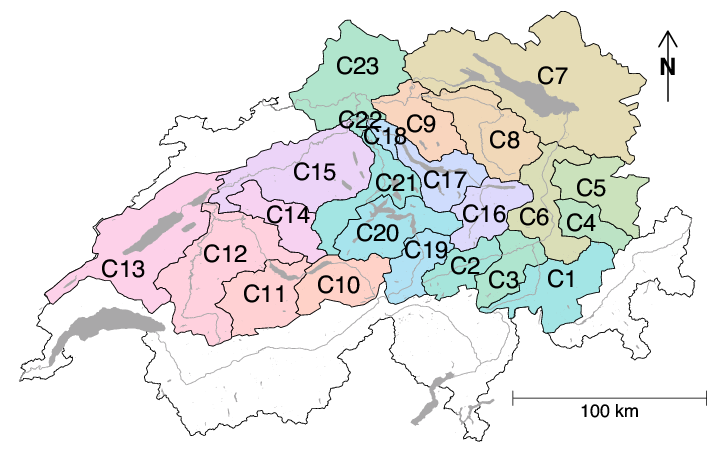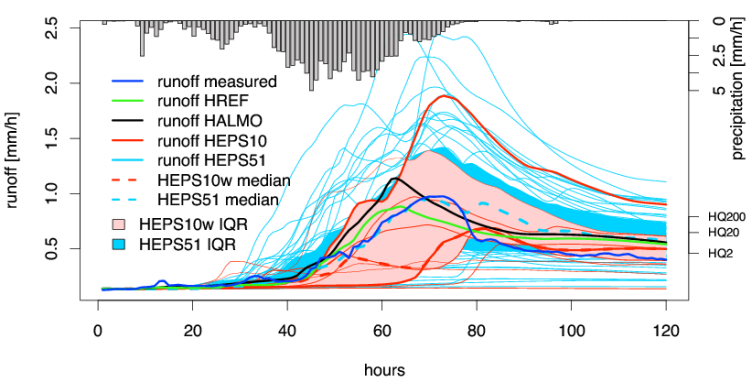Hydrology of Alpine catchments
Ensemble forecasts and uncertainties

The Alpine region is exposed to a high frequency of extreme precipitation events and is particularly vulnerable to their secondary effects like floods, landslides and erosion, which endanger environment, inhabitants and infrastructure. To mitigate the consequences of such events, reliable quantitative precipitation and flood forecasts with sufficient lead time are needed. The production of hydrological forecasts with sufficient lead time requires the use of coupled hydrometeorological models. However, numerically simulated precipitation (needed as input) contains large uncertainties. The latter arise from the use of imperfect numerical models and from the chaotic nature of the atmospheric dynamics, and can effectively limit the skill of a deterministic hydrological forecast. This effect can be partly encompassed by following a probabilistic approach based on ensemble forecasts.

Within the scope of external pageCOST 731call_made we try to assess the propagation of uncertainty in advanced meteo-hydrological forecast systems, especially investigating the benefits of applying a coupled meteorological-hydrological ensemble prediction system. The employed hydrological model is the semi-distributed hydrological model external pagePREVAHcall_made. The model is applied to the Alpine tributaries of the Rhine river basin (see Fig.1). The meteorological inputs come a) from observations, to provide the initial conditions of the hydrological model b) from deterministic meteorological forecasts (from the NWP model external pageCOSMOcall_made of MeteoSwiss) and c) from a meteorological ensemble prediction system (external pageCOSMO-LEPScall_made). This setup was applied for several case studies characterized by heavy precipitation events (May 1999, November 2002, August 2005: see publication list below and Fig.2). We found a good hindcast performance of the applied coupled meteorological-hydrological ensemble forecast system. The additional probabilistic information helps to classify the deterministic forecast and provides useful information about its uncertainty. To further assess the applicability of such a system, a study providing two years of continuous probabilistic hindcasts is currently in progress.
We are also producing real-time hydrological ensemble forecasts. This work takes place in the context of the MAP-D-PHASE program.
Climate change and its effects on hydrological processes
The Rhine catchment frequently experiences floods such as in December 1993 and January 1995. Given the exposition to floods, it is important to address the question of how the floods along the Rhine are going to change under a climate change scenario. Based on earlier studies (Kleinn 2005, Graham 2007) regarding the effect of climate change onto hydrological processes, a project is going on to evaluate the changes in flood frequency and intensity along the Rhine under changing climate conditions. A special focus is given on the propagation of the uncertainty associated with climate models.
National and international cooperation
external pageMAP D-PHASEcall_made
external pageMeteoSwisscall_made
external pageWSLcall_made
Selected publications:
Zappa, M., M.W. Rotach, M. Arpagaus, M. Dorninger, C. Hegg, A. Montani, R. Ranzi, F. Ament, U. Germann, G. Grossi, S. Jaun, A. Rossa, S. Vogt, A. Walser, J. Wehrhan, and C. Wunram, 2008: MAP D-PHASE: real-time demonstration of hydrological ensemble prediction systems. Atmospheric Science Letters, 9, 80-87
Jaun, S., B. Ahrens, A. Walser, T. Ewen, and C. Schär, 2008: A probabilistic view on the August 2005 floods in the upper Rhine catchment. Nat. Hazards Earth Syst. Sci., 8, 281-291
Verbunt, M.; Walser, A.; Gurtz, J.; Montani, A., Schär, C. (2006): Probabilistic Flood Forecasting with a Limited-Area Ensemble Prediction System: Selected Case Studies, J. Hydrometeorol., 8, 897-909
Kleinn, J.; Frei, C.; Gurtz, J.; Luethi, D.; Vidale, P. and Schär, C. (2005): Hydrologic Simulations in the Rhine Basin driven by a Regional Climate Model, J. Geophys. Res., 110, D04102
Graham, L. P.; Hagemann, S.; Jaun, S. and Beniston, M. (2007): On interpreting hydrological change from regional climate models, Climatic Change, 81 , 97-122
